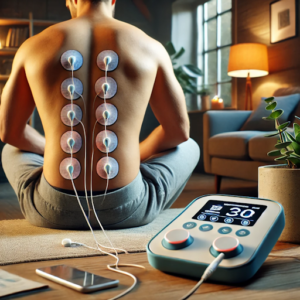Effectively Managing Back Pain Through Electrotherapy
Back pain is a widespread issue affecting millions worldwide, transcending age, gender, and lifestyle factors. It can manifest in various ways, from sharp discomfort lasting a few days to chronic pain that persists for months or years. Often, back pain stems from a combination of physical, psychological, and environmental factors.
Common causes of back pain include muscle strain, herniated discs, arthritis, and poor posture. The variability in how back pain is experienced complicates diagnosis and treatment. While some may find the pain tolerable, others could be severely debilitated, requiring a comprehensive approach from healthcare professionals.
Beyond physical health, chronic back pain can take a toll on emotional well-being, often leading to anxiety, depression, and social isolation. The economic implications are substantial, as back pain is one of the leading causes of disability and reduced productivity in workplaces.
Understanding the underlying causes of back pain is crucial for developing effective treatment strategies. One such strategy is electrotherapy, which has gained recognition for its ability to relieve pain and promote recovery.
Summary
- Back pain may result from factors like poor posture, muscle strain, or injury and significantly impact daily life.
- Electrotherapy is a non-invasive technique that uses electrical energy to manage pain and promote healing.
- Electrotherapy offers pain relief, muscle relaxation, improved circulation, and reduced inflammation.
- Different electrotherapy methods like TENS and EMS can help alleviate back pain.
- When using electrotherapy, it's important to follow healthcare professional advice and avoid using it near the heart or on broken skin.
 Introduction to Electrotherapy
Introduction to Electrotherapy
Electrotherapy refers to various techniques that use electrical energy to treat conditions like back pain. This therapeutic approach has evolved, utilizing advanced technologies to offer pain relief and promote healing. Electrotherapy can target specific areas of discomfort by stimulating nerves and muscles through electrical impulses.
Unlike medications, which may cause side effects or dependency, electrotherapy is non-invasive and effective in managing back pain. As research continues, the benefits of electrotherapy are becoming more widely recognized, leading to its integration into comprehensive pain management plans.
Benefits of Electrotherapy for Back Pain
One of the primary benefits of electrotherapy is its ability to provide immediate pain relief. Elect electrotherapy interrupts pain signals by sending electrical impulses to the affected area, reducing discomfort.
Additionally, it promotes the release of endorphins, the body's natural pain relievers, further enhancing its effectiveness. Electrotherapy also improves blood circulation and reduces inflammation, supporting the healing process. This combination of immediate and long-term benefits makes electrotherapy a valuable tool for managing back pain.
Types of Electrotherapy for Back Pain
Electrotherapy encompasses various methods, each targeting different aspects of back pain management. TENS (Transcutaneous Electrical Nerve Stimulation) is a popular technique that delivers low-voltage electrical currents to relieve pain. Its portability and ease of use make it ideal for home treatment.
IFC (Interferential Current Therapy) uses medium-frequency electrical currents to reach deeper tissues and address musculoskeletal issues. Additionally, EMS (Electrical Muscle Stimulation) and microcurrent therapy are increasingly recognized for stimulating muscle contractions and aiding tissue repair.
 How to Use Electrotherapy for Back Pain Management
How to Use Electrotherapy for Back Pain Management
Following specific guidelines is crucial to ensuring safety and effectiveness when using electrotherapy. Patients should consult a healthcare provider to determine the best electrotherapy option. Once a treatment plan is in place, therapy can be administered in a clinical setting or with portable devices at home.
Home users must follow the manufacturer's instructions for electrode placement, intensity, and session duration. A typical session lasts between 20 and 60 minutes. Consistency is key, as regular treatments offer cumulative benefits over time. Regular communication with a healthcare provider is essential to track progress and make adjustments if needed.
Precautions and Considerations When Using Electrotherapy
Although electrotherapy is generally safe, certain precautions should be taken to avoid complications. Individuals with heart disease, epilepsy, or implanted devices like pacemakers should consult a healthcare provider before using electrotherapy. Pregnant women are also advised to avoid electrotherapy near the abdomen or lower back.
It is important to avoid placing electrodes on open wounds or infected areas. Patients should also monitor their bodies for adverse reactions during treatment and stop immediately if they experience increased pain or skin irritation.
 Integrating Electrotherapy with Other Back Pain Management Techniques
Integrating Electrotherapy with Other Back Pain Management Techniques
Integrating electrotherapy with other treatments can enhance back pain management. A holistic approach often yields better results than relying on a single therapy. Combining electrotherapy with physical therapy can strengthen muscles and improve flexibility while addressing underlying musculoskeletal problems.
Making ergonomic adjustments at work or home can further enhance the benefits of electrotherapy by reducing strain on the back. Additionally, incorporating stress-reducing practices like yoga or meditation can help alleviate pain perception by promoting relaxation.
FAQs
Can you tell me about electrotherapy for back pain?
Electrotherapy uses electrical stimulation to manage and relieve back pain—standard methods in inStandardTENS and EMS.
How might electrotherapy help with my back pain?
Electrotherapy stimulates nerves and muscles to improve blood flow, promote healing, block pain signals, and trigger the production of endorphins, the body's natural painkillers.
Is it safe to use electrotherapy for back pain?
Electrotherapy is generally safe when guided by a trained healthcare provider. Follow recommended protocols and avoid applying the device near the head or heart.
How does electrotherapy work for back pain?
Electrotherapy relieves pain, reduces muscle spasms, and improves flexibility. It's a non-invasive and drug-free option for managing back pain.
Who can benefit from electrotherapy for back pain?
Electrotherapy may benefit individuals with conditions such as strained muscles, arthritis, sciatica, or herniated discs as part of a broader pain management strategy.
Are there any situations where electrotherapy isn't recommended?
Electrotherapy is not recommended for individuals with pacemakers, epilepsy, or heart conditions. Consult a doctor before starting treatment.
Brought To You By: Back Pain Therapy
The Article: Managing Back Pain with Electrotherapy appeared first on https://mcrtherapies.co.uk
The Article Managing Back Pain with Electrotherapy appeared first on https://mcrtherapies.com





Comments are closed